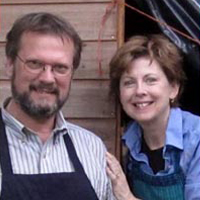


Member, Freestyle Advisory Board of Photographic Professionals
Mark Osterman began research in historic photographic processes while attending the Kansas City Art Institute in the 1970s and for twenty years, taught fine art photography at George School, Newtown, PA. In his current position, he researches and teaches the technical evolution of photography for the Center for the Legacy of Photography at George Eastman House International Museum of Photography in Rochester, NY. Osterman's most recent writings on the subject of historic photographic processes include the 19th century chapter for the Focal Encyclopedia of Photography (2007) and a chapter on making gelatin emulsions for the Book of Alternative Photographic Processes, by Christopher James (2008). France Scully Osterman is an artist, teacher, and guest scholar at George Eastman House. She runs Scully & Osterman Skylight Studio in Rochester, NY, where she also teaches workshops and private tutorials. She is recognized for her knowledge of historic processes, most notably, wet-plate collodion, salt and albumen prints, and for the long list of accomplished artists who have studied with her. In 1991, the couple formed Scully & Osterman. Together, they co-published the quarterly publication The Collodion Journal (1995-2002), and have given lectures, demonstrations and workshops throughout the United States, Canada, Mexico, Japan and Europe. As artists and writers, their work has been featured in Photography's Antiquarian Avant-Garde, The New Wave in Old Process Photography by Lyle Rexer, Coming into Focus by John Barnier, The Book of Alternative Photographic Processes by Christopher James (both editions), Le Vocabulaire Technique de la Photographie by Anne Cartier-Bresson (2008) and the third edition of Photographic Possibilities, by Robert Hirsch (2009). Their images are in the collections of the Museum of Fine Art, Houston; The Nelson-Atkins Museum, Kansas City; George Eastman House International Museum of Photography, Rochester; Harry Ransom Center at the University of Texas, Austin; Museum of Western Virginia, Roanoke; Herbert F. Johnson Museum of Art, Cornell University, Ithaca; Michener Museum, Doylestown, PA and numerous private collections. The Ostermans are represented by Howard Greenberg Gallery, NYC and Tilt Gallery, Phoenix, AZ.
| The Lure Of Collodion - Developing the Plate |
| The Lure Of Collodion - Ambrotypes |
| The Lure Of Collodion - Modern Times |